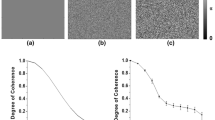Abstract
Speckle is one of the main obstacles to application of self-mixing interferometer. Self-mixing model reflecting speckle is of great theoretical and practical significance in self-mixing interferometry. In the paper, we suggested an improved model which can clearly explain the effect of speckle on self-mixing signal, and draw some important results such as a mechanism of feedback coefficient intensity variation induced by speckle and effects of the surface orientation on the signal. The proposed model and method will provide an effective tool for practical application of self-mixing interferometer.









Similar content being viewed by others
Data availability
No datasets were generated or analysed during the current study.
References
Z. Zhang et al., Vibration measurement based on the local maximum detection algorithm for laser self-mixing interferometry. IEEE Access 8, 63462–63469 (2020)
C. Kim et al., Amelioration of accuracy of displacement measurement in strong feedback regime based on region decision: enlargement of measurement range of self-mixing displacement sensor. Opt. Commun. 532, 129257 (2023)
S.A. Abid, U. Zabit, O.D. Bernal, Fringe detection and displacement sensing for variable optical feedback-based self-mixing interferometry by using deep neural networks. Sensors 22, 9831 (2022)
W. Sun, Z. Yang, G. Feng, Z. Chen, Q. Chang, L. Hai, Z. Guo, A novel method for detecting Fe2+ at a micromolar concentration based on multiple self-mixing interference using a fiber laser. Sensors 23(5), 2838 (2023)
R. Li, Z. Hu, H. Li, Y. Zhao, K. Liu, Y. Tu, L. Lu, All-fiber laser-self-mixing interferometer with adjustable injection intensity for remote sensing of 40 km. J. Lightw. Technol. 40(14), 4863–4870 (2022)
W. Yifan, X. Xu, Z. Dai, Z. Hua, C. Lin, Y. Hou, Q. Zhang, P. Wang, Y. Tan, Frequency-swept feedback interferometry for noncooperative-target ranging with a stand-off distance of several hundred meters. PhotoniX. (2022). https://doi.org/10.1186/s43074-022-00067-z
I. Ahmed, U. Zabit, A. Salman, Self-mixing interferometric signal enhancement using generative adversarial network for laser metric sensing applications. IEEE Access 7, 174641–174650 (2019)
C. Kim et al., ‘Effect of linewidth enhancement factor on fringe in a self-mixing signal and improved estimation of feedback factor in laser diode.’ IEEE Access 7, 28886–28893 (2019)
C. Jiang, Y. Geng, Y. Liu, Y. Liu, P. Chen, S. Yin, Rotation velocity measurement based on self-mixing interference with a dual-external-cavity single-laser diode. Appl. Optics 58(3), 604–608 (2019)
U. Zabit, O.D. Bernal, T. Bosch, Self-mixing laser sensor for large displacements: signal recovery in the presence of speckle. IEEE Sens. J. 13(2), 824–831 (2013)
H. Zhen, L. Chengwei, L. Songquan, Z. Zhenghe, L. Dongyu, Speckle affected fringe detection based on three envelope extraction for self-mixing displacement measurement. Opt. Commun. 392, 100–108 (2017)
R. Atashkhooei, S. Royo, F.J. Azcona, Dealing with speckle effects in self-mixing interferometry measurements. IEEE Sen. J. 13(5), 1641–1647 (2013)
S. Donati, G. Martini, T. Tambosso, Speckle pattern errors in self-mixing interferometry. IEEE J. Quant. Electron 49(9), 798–806 (2013)
A.L. Arriaga, F. Bony, T. Bosch, Speckle-insensitive fringe detection method based on Hilbert transform for self-mixing interferometry. Appl. Opt. 53(30), 6954 (2014)
S. Donati, G. Martini, Systematic and random errors in self-mixing measurements: effect of the developing speckle statistics. Appl. Opt. 53(22), 4873 (2014)
M. Norgia, S. Donati, Interferometric measurements of displacement on a diffusing target by a speckle tracking technique. IEEE J. Quant. Electron. 37(6), 800–806 (2001)
J.-H. Kim, C.-H. Kim, T.-H. Yun, H.-S. Hong, K.-M. Ho, K.-H. Kim, Joint estimation of self-mixing interferometry parameters and displacement reconstruction based on local normalization. Appl. Opt. 60(5), 2282 (2021)
C.-H. Kim, H.-S. Hong, T.-H. Yun, K.-H. Kim, J.-H. An, W.-S. Ju, Improvement of precision of self-mixing displacement sensor based on region tracking for large displacement. Opt. Commun. 508, 127807 (2022)
U. Zabit, Optimization of a self-mixing laser displacement sensor, Ph.D. dissertation. Institut National Polytechnique de Toulouse (2010)
J. W. Goodman, Introduction to fourier optics. Roberts and Company publishers (2005)
N. Garcia, E. Stoll, Monte Carlo calculation for electromagnetic-wave scattering from random rough surfaces. Phys. Rev. Lett. 52, 1798–1801 (1984)
S. Donati, G. Giuliani, S. Merlo, Laser Diode Feedback Interferometer for Measurement of Displacements without Ambiguity. IEEE J. Quant. Electron. 31(1), 113–119 (1995)
Ethics declarations
Conflict of interest
The authors declare no competing interests.
Additional information
Publisher's Note
Springer Nature remains neutral with regard to jurisdictional claims in published maps and institutional affiliations.
Rights and permissions
Springer Nature or its licensor (e.g. a society or other partner) holds exclusive rights to this article under a publishing agreement with the author(s) or other rightsholder(s); author self-archiving of the accepted manuscript version of this article is solely governed by the terms of such publishing agreement and applicable law.
About this article
Cite this article
Ho, KM., Choe, SA., Kim, CH. et al. Improved self-mixing model reflecting speckle. Appl. Phys. B 130, 44 (2024). https://doi.org/10.1007/s00340-024-08179-z
Received:
Accepted:
Published:
DOI: https://doi.org/10.1007/s00340-024-08179-z




